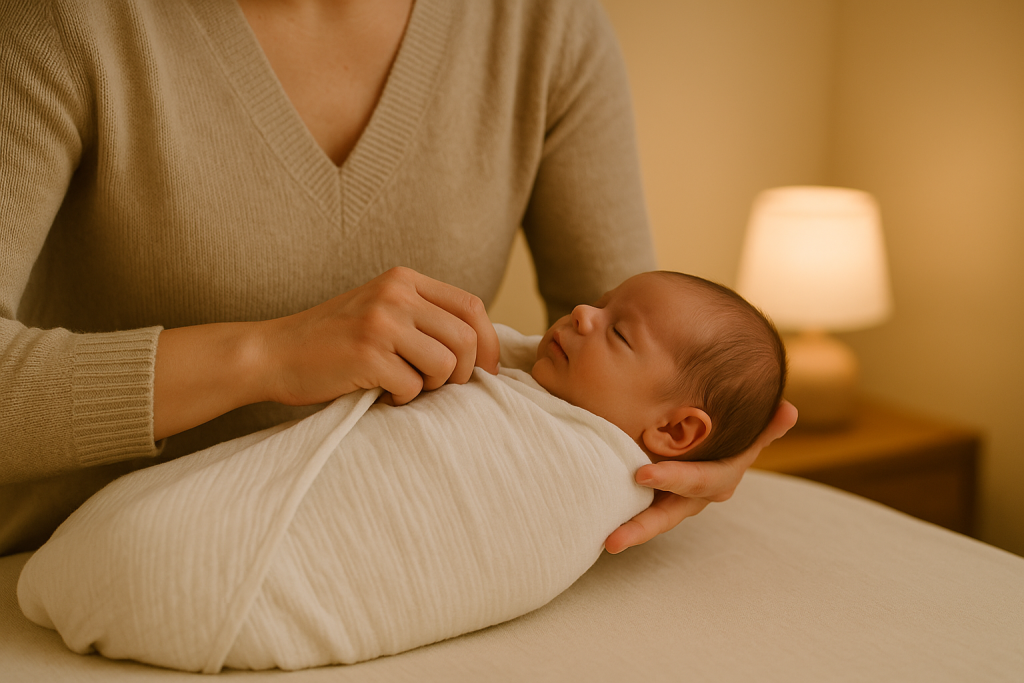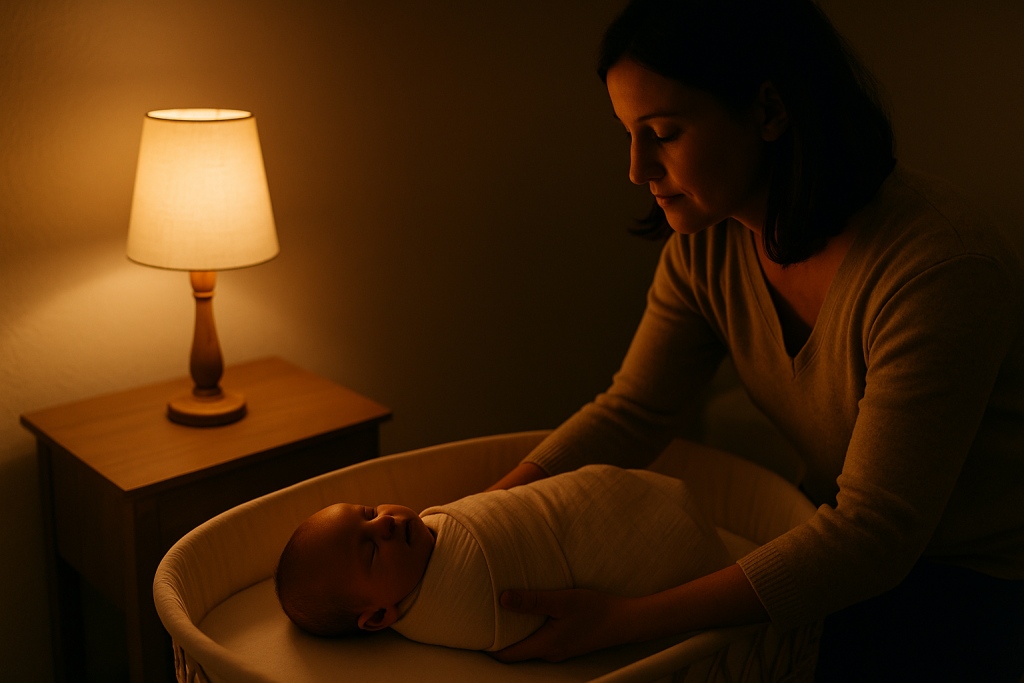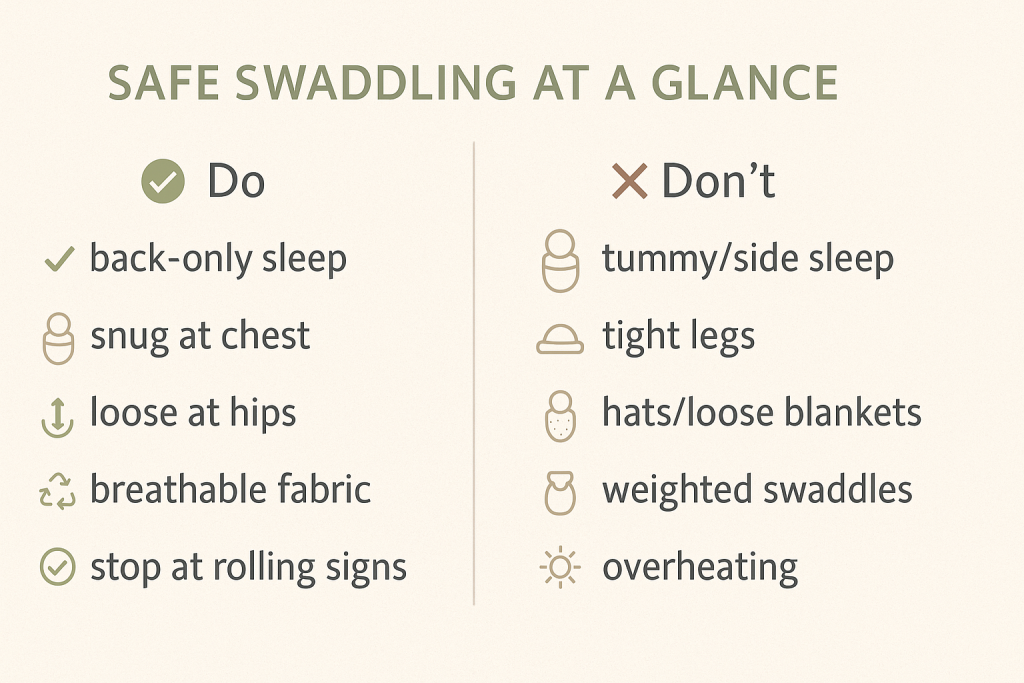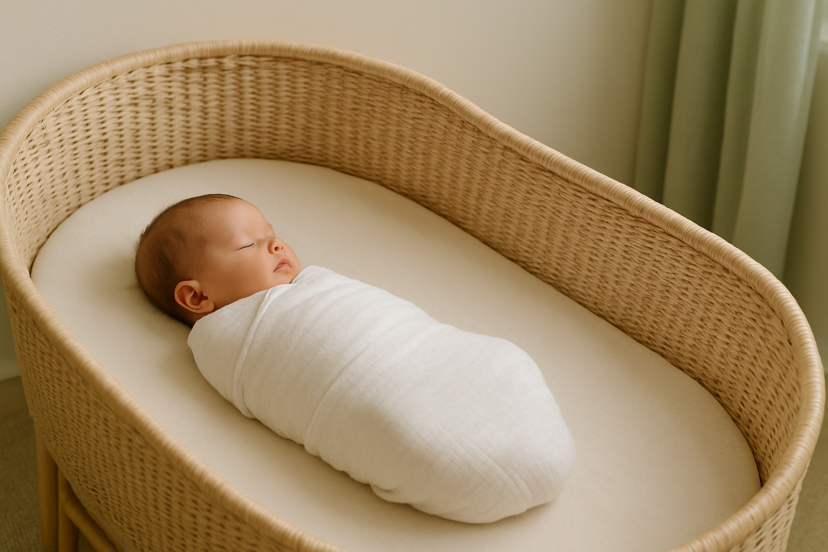Newborns and Swaddling: Benefits, Myths, and Tips
We may earn a commission for purchases made using our links. Please see our disclosure to learn more.
You’ve probably heard that swaddling can be a game-changer… and then you’ve also heard warnings that make you second-guess everything. If you’re feeling torn, you’re not alone. In this friendly guide, we’ll walk through newborns and swaddling—what it is, why it helps, how to keep it safe, when to stop, and which swaddles real parents love. You’ll leave with practical steps, evidence-based tips, and gentle confidence.
What Is Swaddling, Really?
Swaddling is simply wrapping your baby snugly in a light blanket or using a purpose-made swaddle so they feel cozy and contained—like a warm “hug” that reminds them of the womb. It can help temper the moro (startle) reflex, which often wakes newborns right as they drift off.
Why Newborns Love the Swaddle (Benefits)
Parents often notice longer stretches of calm, easier transitions from arms to bassinet, and fewer “startle-awake” moments. Studies indicate that swaddling may help infants spend more time in quiet sleep and experience fewer sleep disruptions, particularly when they’re first introduced to it.
Myth-Busting: Newborns and Swaddling
- Myth: Swaddling makes babies overheat.
Fact: Any sleep setup can cause overheating if layers are excessive. Use breathable fabrics, dress lightly, and check baby’s chest (warm, not sweaty). - Myth: Swaddling is unsafe, full stop.
Fact: Swaddling can be done safely when you always place baby on their back, keep the wrap snug at the chest and loose at the hips, and stop at the first signs of rolling. - Myth: All swaddles are equal.
Fact: Fit, fabric, and closure style matter. The “best” option is the one you can apply correctly at 2 a.m.

Safety First: The Golden Rules
The American Academy of Pediatrics (AAP) emphasizes a back-only sleep position, a firm, flat sleep surface, and no loose bedding in the crib. If you swaddle, do it correctly and never place a swaddled baby on their side or tummy. The AAP also cautions against weighted swaddles.
Quick check: Baby’s face is visible, airway is clear, the wrap is secure at the chest, hips and legs can bend and splay, and baby sleeps on the back—every time.
When to Stop Swaddling (Rolling & Readiness)
Swaddling should end as soon as your baby shows signs of attempting to roll—often around 3–4 months, though it can happen earlier. At that point, transition to an arms-out option like a sleep sack.
Hip-Healthy Swaddling
Tight wrapping of the legs straight down increases the risk of hip dysplasia. International Hip Dysplasia Institute guidance: keep hips and knees in slight flexion and abduction and allow room for movement. Many modern swaddles are designed with roomier bottoms for this reason.
Fabrics, TOG Ratings & Room Temps
Choose breathable cotton or muslin for warm weather; consider light fleece or higher TOG for cooler nights. The goal is a baby who’s comfortably warm, not sweaty. Many brands list a TOG (warmth) rating and suggested room ranges on product pages—use those as guides and adjust layers based on your climate and your baby’s cues.
Arms-In, Arms-Out, and Transition Choices
- Arms-in: Best for brand-new babies with strong startle reflexes.
- One-arm-out: Helpful for babies who rub cheeks to self-soothe or are starting to bust free.
- Arms-out: Use once rolling attempts appear or earlier if baby prefers freedom.
- Transition swaddles/sacks: Hybrid styles make this shift smoother for everyone.

Step-by-Step: How to Swaddle a Newborn
The Classic Blanket Method (Muslin)
- Lay out a large muslin in a diamond; fold the top corner down.
- Position your baby so the shoulders sit just beneath the folded edge, while supporting the head and neck.
- Left flap across chest, tucking under the back, leaving room at the hips.
- Bottom up loosely over the legs (hips free).
- Right flap across and tuck; check snug-at-chest, loose-at-hips fit.
The Fast-Zip Method (Swaddle Sacks)
- Place baby in the sack; align shoulders with seam.
- Zip/secure per design (Velcro, zipper, snaps).
- Confirm back sleep position and hip room.
Troubleshooting Common Swaddle Struggles
- Baby fights the swaddle: Try one arm out, switch fabric (cooler), or a different closure style.
- Houdini escaping: Re-check size; switch to a zippered swaddle.
- Sweaty chest/neck: Remove a layer or choose a lower TOG.
- Fussy at bedtime: Swaddle is soothing, but it’s not magic—pair with a short, predictable routine.
Swaddling in Warm Climates (Stay Cool, Stay Safe)
If you live somewhere warm or humid, choose lightweight, breathable fabrics and keep the room well-ventilated. Avoid overdressing. Babies run warmer than we think; check their chest and nape for sweat and adjust. The AAP’s safe-sleep recommendations flag overheating as a risk to avoid.
Sleep Sacks vs Swaddles: What’s the Difference?
A swaddle gently contains a newborn’s arms and torso. A sleep sack is a wearable blanket with arms free—great after the swaddle stage and for ongoing safe sleep (no loose blankets). Many families use swaddles for the early weeks, then switch to sacks when rolling signs appear.
🔹 Top Amazon Swaddle Picks (with Pros, Cons & Use Cases)
Below are five parent-loved options. Choose based on your baby’s preferences (arms-up vs arms-down), your climate, and how fast you want bedtime to be. (Links shown in citations.)
1) Love to Dream Swaddle UP (Original, Stage 1)
Why parents pick it: Arms-up design lets babies self-soothe while still dampening startle. Stretchy knit keeps chest snug and hips free.
Features: Arms-up wings, two-way zipper, soft cotton-elastane blend.
Pros: Easy zip; great for face-rubbing self-soothers; fast diaper changes.
Cons: Not ideal if your baby settles better arms-down.
Best for: Babies who love hands near their cheeks; quick swaddle setup.
2) HALO SleepSack Swaddle (100% Cotton, 3-Way)
Why parents pick it: Hospitals use it for a reason—3-way wrap (arms-in, hands-to-face, or one-arm-out) is flexible and intuitive.
Features: Velcro wings, roomy bottom, cotton knit, clear size/TOG guidance.
Pros: Versatile positions; easy learning curve.
Cons: Velcro can be loud at night; wash with wings closed.
Best for: Parents who want one swaddle that adapts week to week.
3) SwaddleMe Original (3-Pack, Cotton)
Why parents pick it: Budget-friendly set with straightforward wings and firm hold.
Features: Hook-and-loop wings, cotton jersey, size/weight guidance.
Pros: Affordable; simple; great backups for laundry days.
Cons: Strong Velcro is less forgiving on fit; can be warm if layered.
Best for: Newborn basics, multiples, backup swaddles.
4) Woombie Original Swaddle (Zip-Up)
Why parents pick it: Peanut-shaped, stretchy, and fuss-free—just zip. Encourages back sleeping and gentle containment.
Features: One-piece zipper design; cotton-spandex; hip-friendly shape.
Pros: Harder to “bust out”; soft, cocoon feel.
Cons: Less adjustable than winged options; sizing matters.
Best for: “Houdini” babies and parents who want zero origami.
5) aden + anais Classic Muslin Swaddles (4-Pack)
Why parents pick it: The classic blanket—breathable, huge, and multi-use (swaddle, stroller shade, burp cloth, tummy-time mat)
Features: Large 44–47″ squares; 100% cotton muslin; airy weave.
Pros: Versatile; great for warm climates; washes well.
Cons: Learning curve for tight-but-safe wrap; baby may escape.
Best for: Parents who want one textile to do everything.
Product Comparison at a Glance
| Model | Key Spec(s) | Warranty* | Approx Price/Tier | Best For |
| Love to Dream Swaddle UP (Original) | Arms-up, 2-way zip, cotton-elastane | Manufacturer/varies | Mid-range | Self-soothers; fast bedtime |
| HALO SleepSack Swaddle (Cotton) | 3-way wrap, roomy bottom, cotton knit | Manufacturer/varies | Mid-range | Flexible positions; easy learning |
| SwaddleMe Original (3-Pack) | Hook-and-loop wings, cotton jersey | Manufacturer/varies | Budget | Extra backups; simple wrap |
| Woombie Original | Zip-up cocoon, cotton-spandex | Manufacturer/varies | Mid-range | “Houdini” babies; no-fuss zip |
| aden + anais Muslin (4-Pack) | Large muslin blankets, breathable | Manufacturer/varies | Varies | Warm climates; multi-use |
*Warranty details often vary by seller; check the product page at purchase.
Review snapshot (themes across listings): Parents praise easier settling, faster changes (zips!), and breathable fabrics. Common complaints include size confusion and Velcro noise at night.

🧪 Research-Backed Insights on Swaddling
Two threads matter most: sleep quality and safety.
- Sleep & soothing: A recent review notes that swaddling can increase quiet sleep and reduce startle-related arousals—especially in infants new to the practice—supporting what many parents observe at home. See this systematic review on swaddling and sleep.
- Safety & positioning: An individual-level meta-analysis found that SIDS risk was highest when swaddled infants slept prone (on the tummy), elevated for side-sleeping, and lowest for back-sleeping—another reason the AAP’s back-only rule matters so much. Read the meta-analysis on swaddling and SIDS risk and the AAP 2022 safe-sleep recommendations. Also avoid weighted swaddles.
Setting Up Your Newborn Sleep Space (Essentials)
Keep it simple and safe: a firm mattress, fitted sheet, and your chosen swaddle. No pillows, bumpers, or loose blankets. If you’re building your starter kit, here’s a helpful checklist of newborn essentials (bassinet, breathable swaddles, gentle jammies, and more). See our guide to must-have newborn essentials for an easy, parent-tested list.
Explore a simple newborn essentials checklist (organized by sleep, feeding, and on-the-go).
FAQs
How tight should a swaddle be?
Snug across the chest and shoulders (so fabric can’t ride up), yet loose over the hips and legs so baby can bend and splay. You should fit two fingers at the chest.
Can swaddling reduce the startle reflex?
Yes—swaddling helps calm the startle reflex and can lengthen quiet sleep, particularly in infants who are new to swaddling. Always follow safe-sleep rules.
When do I stop swaddling my newborn?
Stop immediately when your baby shows signs of attempting to roll (often around 3–4 months, sometimes earlier). Transition to an arms-out sleep sack.
Are weighted swaddles safe?
The AAP advises against weighted swaddles or placing weights in a swaddle. Choose standard, breathable materials instead.
Is a sleep sack safer than a loose blanket?
Yes. Sleep sacks are wearable blankets that remove loose bedding from the crib, aligning with safe-sleep recommendations.
A Gentle Wrap-Up
You don’t need to swaddle perfectly; you just need to swaddle safely and responsively. Start with a breathable fabric, keep hips free, place baby on the back, and watch for rolling signals. Then, choose what works for your unique little human—arms-up, arms-down, or straight to a sleep sack. You’ve got this. And on the nights you feel unsure, remember: the goal isn’t perfect technique; it’s a calmer, safer path to rest for both of you.




